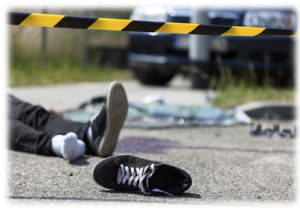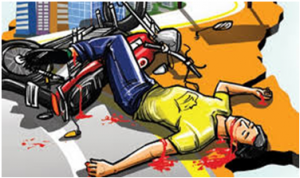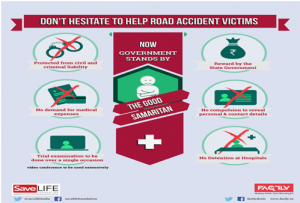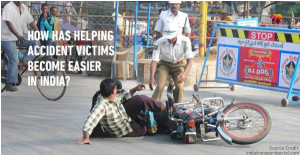In this blog post, Disha Pareek, a student of RGNUL Patiala writes about the legal provisions in India for tackling the problem of road accidents which is growing at an exponential rate.
With the development of civilization and a tremendous change in lifestyles of Indians, there is a steep rise in the number of vehicles plying on the roads. Due to busy lives, people are careless about their driving. Road accidents contribute a lion’s share to the death and disability.
A Road Traffic Accident (RTA) can be defined as a crashing between vehicles, or between any pedestrian and vehicle, in which involvement of at least one running vehicle is a must.[1] India witnesses at least one road mishap every minute, and every 4 minutes, death due to road accident takes place. As per a government statistics-
| CAUSE | DEATH TOLL (per year) |
| Road accident | Nearly 5 Lakh (injured)
|
| Crashing of vehicles | 1.4 Lakh (died)
|
| Road accident | 16 (per hour, dead)
|
If we look at the report of Maruti Suzuki,[2] it states that every year about one Lakh Indians die in road accidents due to negligent and rash driving and the steep rise in the number of vehicles.
Major reasons
There are a lot of reasons, but some of the primary reasons are
- The legal age for driving in India is 18, but since there is no compliance with the law, even minors who do not have sufficient maturity drive vehicles, and the parents allow this. And the consequences have to be borne by the innocent pedestrians, the latest case being the hit-and-run case by a minor who killed a man in Delhi with his Mercedes.
- Many people, primarily the younger generation crosses the speed limit and speeding is one of the major causes of deaths on roads
- Drunk and reckless driving is another major cause, and this is one such cause which contributes the most to daily deaths.
- Television too has affected the youth. The youth, by imitating the actions and stunts shown on television without proper guidance, they end up either injuring or killing something.
Laws on motor vehicle in India
Motor Vehicles Act, 1988
When a road accident takes place, it involves a liability (both civil and criminal), and this Act deals with the issues of such accidents. It provides with all the related rules and guidelines. The Motor Vehicles Act came into force in the year 1989.
Main provisions
- Section 3 of the Act mandates that without having a driving license which should be effective and which authorizes a person to drive the vehicle,[3] nobody should be allowed to drive
But there must be a strict procedure while granting a license and the concerned authorities must check beforehand that the person is capable of driving
- Section 4 is in a way related to Section 3 as it provides the age limit, which is 18 years, to drive legally.
- The Act also imposes a responsibility in the context of Sections 3 and 4 so that they strictly observe the laws. Therefore, neither the owner nor the person in charge of the vehicle shall allow a person who does not qualify the essentials of Sections 3 and 4 to drive.
- Anybody who wants to get a vehicle must have knowledge about the registration of the same.
Under the Motor Vehicles Act from Section 39-65, the whole procedure for registration of a vehicle has been laid down, which also includes different provisions relating to diplomats, central government officers, etc.
Section 132: things to be done at the time of road accident (Driver’s duty)
After an accident has taken place, the first and foremost duty is of the driver himself. He should not get panic and run away from the scene of the accident but should responsibly wait for the police officer for a reasonable time, though a ‘reasonable time’ differs from case-to-case.
The problem in India is that here the money quotient plays an important role, and there have been cases where the rich either run away or steer clear of the charge. For instance, the case of Hema Malini is the recent example in which the emergency treatment was given to her instead of the child in the other car who was severely injured. Even section 134 of the Act requires immediate action by the driver or the person in charge to take the injured person to the nearest hospital, and inform the police as soon as possible. There is a separate chapter on the non-compliance of the provisions of the Act from Sections 177 -210 where all the details have been provided.
Compensation to the aggrieved party
As per the provisions of the Act, the aggrieved party has 3 modes by which he could get compensation.
- Principle of “No Fault Liability[4]”: it means that even without any fault of the person causing the accident, he shall be liable, and the claimant (injured party) need not plead before the court to prove any fault/negligence on driver’s part. And he will get a fixed sum of Rs 25000 in the case of permanent disablement and Rs 50000 in case death has occurred.
- The second principle is in case of ‘Hit-and-run’[5] case, the statute provides that when a person causes an accident he should give his name and license number to the authorities concerned, but when such identity is disguised, meaning that the person runs away from the place, in that case there is a provision of paying a fixed amount of Rs 25000 and Rs 12500 in case of death and disability respectively from the funds of the government.
- Lastly by Section 163A of the Act that is ‘structured formula basis’: here also the claimant need not prove rashness of the driver. In this case, the vehicle’s owner or the authorized insurer has to compensate and the identity of the accused must be known in this case.
Criminal liability under Indian Penal Code
- The first provision that imposes criminal liability on the accused is Section 304A that is, when due to the rash or negligent act of the driver, an accident is caused, that person shall be punished with imprisonment of the term which may extend to 2 years or fine.[6]
Here, the major criticism is the proof of the entire fault or negligence on the part of the offender and that the offender’s action was the direct and immediate cause of the collision/accident. Many a time, even after the person’s fault, his immediate involvement is difficult to prove. And the offense being non-bailable, injustice is done to the victim/family many times.
- An act of rash driving even without causing any harm is punishable under IPC, provided that act endangers human life or safety. This will be punishable with either an imprisonment of three months or a fine of Rs 250.[7]
New Motor Vehicles Bill, 2015
The Ministry of Road, Transport, and Highways[8] has decided to propose a bill to reform and amend the current Motor Vehicles Act, 1988 and according to the proposal, recommendation of more fines has been made along with stringent punishment to the offenders. The new bill does not give many powers to the state.
Loopholes in the law
- In any law, there is always scope for reforms. In the Motor Vehicles Act, 1988 the powers are under the Central government, but given the difference in the development and infrastructure of every state, each state should have powers to frame their rules and penalties accordingly.
- The current fines are peanuts for the affluent people, and they do not mind paying exorbitant fines. Therefore they should be increased but at the same time, it should suit the poor.
- The procedure of getting a driver’s license needs change. Firstly, it should be made online so that it becomes convenient and it should depend on the capability of the each driver and not his connections.
- There should also be monthly assessment to test the physical competence of the driver. By all these measures a lot of contribution can be made to avoid accidents and deaths.
Role of different people
When there is an accident, there are various key players whose role becomes prominent.
- The role of traffic police: a traffic police have tremendous responsibilities; half of the accidents could easily be handled if the police do its job carefully.
But unfortunately, due to corruption is the main reason for the setback, anybody even a minor is allowed to drive just by offering a bribe and due to this everybody easily violates traffic rules.
The need of the hour is to make the current rules stricter, and if a traffic police does not perform his duty, a strict action must be taken against him.
- The role of family and parents is a crucial one. They should from the very beginning teach their children not to violate traffic rules, and the minors should never be allowed to drive. This can help to lessen such mishaps.
- Duties of the bystanders: they have the most important role to play, but it is observed that people hesitate to help the victims of accidents, and they have different apprehensions. For instance, they hav\d to disclose their identity and were harassed by police officials and had to visit courts without any fault of theirs.
Even when the bystanders take the victims to hospitals, the hospital administration detains them. People also are hesitant to bear transportation and other costs for a stranger. Most of the bystanders are unaware of who to call and what immediate action to do and thus they do not take action.
Present situation for the Good Samaritans
An NGO ‘Save Life Foundation’ filed a petition in the Supreme Court of India in Save Life Foundation v. Union of India[9] to enable the bystanders to help the victims in a hassle-free manner. And following the court’s order guidelines were issued by the government.
The guidelines are:
- He has no obligation to answer any questions as soon as he takes a victim to the hospital and he can also leave the hospital.
- He is also not obliged to reveal his name/identity.
- As an encouragement to other citizens, the person should be rewarded by the state government.
- To provide hassle-free legal proceedings, the person should be heard in only a single hearing in the court.
- If police or doctor harasses a Good Samaritan, they should be sternly punished.
Footnotes:
[1] Transport Research Wing, Ministry of Road Transport and Highways, Road Accidents in India 2014, New Delhi: Ministry of Road Transport and Highways, Government of India; 2014.
[2]http://www.marutisuzuki.com
[3] Section 3, the Motor Vehicles Act, 1988
[4] Section 140, Motor Vehicles Act, 1988
[5] Section 161, Motor Vehicles Act, 1988
[6] Section 304A, Motor Vehicles Act, 1988
[7] Section 336, Indian Penal Code, 1860
[8] K. Balchand, Hefty penalty coming for driving offense, The Hindu, March 2012
[9] WP No 235 of 2012
 Serato DJ Crack 2025Serato DJ PRO Crack
Serato DJ Crack 2025Serato DJ PRO Crack













 Allow notifications
Allow notifications




There was a case with me where i with an accident in wrong way but there was caeos made by other public and that two drunk from public started to hit me and the person whom i actually dashed was quiet are there any laws to protect these type of situation
And there was a second case in wich i dashed second person the person was not negotiating or even he was not agreeing to go to hospital only thing he did it was he kept oh hiting me with these two cases i am littlery affraid of driveing again
Are there any laws to help in these kind of situations
Cow accident details need: my son without driving licence. yesteday night 10.30 pm one cow accident in road. what is the case ?.